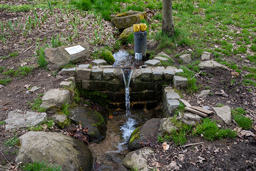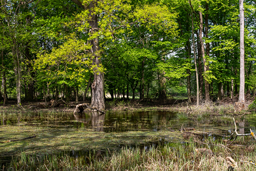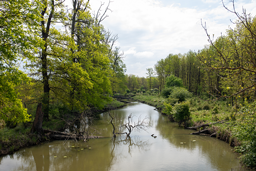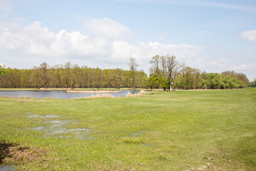Dyje sub-catchment of the DRB
Organization: TGM WRI (Czech Republic)
The Dyje basin, a sub-catchment of the Danube, is struggling with a long-term water shortage caused by the effects of climate change and, at the same time, problematic manipulations (based on historical climate conditions and water supply) at 7 dams on the river Dyje/Thaya catchment, which supplies water to the extensive floodplain forest complex on the borders with Slovakia and Austria.














General Overview
The Demonstration Pilot Site 3 (DPS3) encompasses the Thaya River catchment area, spanning the Czech Republic (83%) and Austria (17%). The Thaya River, a major tributary of the Morava River in the Danube basin, is formed by the Austrian and Moravian Thaya Rivers. The basin faces anthropogenic modifications, including reservoirs for water supply. Annual precipitation varies across the catchment, affecting water resources, which are crucial for households, industry, and agriculture.
The basin features diverse landscapes, from highlands with crystalline bedrock to lowlands with quaternary sediments. Agricultural fertility thrives in the mild climate, with 66% arable land and 28% forest cover. However, coniferous forests have suffered from a bark beetle outbreak due to high temperatures and drought from 2015 to 2019.
The Thaya River flows into the Morava River, forming the Lower Morava Biosphere Reserve (BR) in the Czech Republic, Austria, and Slovakia border triangle. This reserve, an extension of the former BR Pálava, boasts diverse landscapes like limestone cliffs, steppes, forests, meadows, and vineyards. The northeastern part of the BR, in the Thaya floodplain, faces intensive economic use, while the southeast corner preserves the largest complex of hard floodplain and floodplain meadows in Central Europe. The central part, a UNESCO World Heritage site, is part of the RAMSAR Convention for wetland protection.
The Dolní Morava BR includes various specially protected areas, such as Natura 2000 sites, Ramsar Convention wetlands, nature parks, and protected water accumulation areas. The Nature and Landscape Protection Act defines several categories of protected areas, all present in the Dolní Morava BR, except for National Parks. The pilot area is rich in biodiversity and environmental significance, showcasing the importance of conservation efforts.
Implemented measures
The pilot area of the Thaya Basin concentrates on applying research findings from the Lower Morava Biosphere Reserve to drive revitalization initiatives. Uniquely tailored to the Thaya River Basin, these actions serve as a blueprint for smaller-scale replication within the Dalia project, prompted by financial constraints. Central to the revitalization efforts are measures such as the restoration of wetlands, specifically addressing the historical impact of human activities on floodplains and water management projects altering hydrological conditions. Noteworthy Ramsar Convention Wetlands, like the Lednice Fishponds and the Floodplain of the Lower Dyje River, contribute to global endeavors in protecting wetlands and waterfowl habitats.
Post-1989 initiatives strive to counteract the adverse effects of water management, involving public and private entities in restoring wetlands and mitigating habitat loss. Various revitalization projects, including the Allahy forest ponds and the Obelisk floodplain, showcase diverse approaches such as removing overgrowth, dredging, building weirs, constructing sluices, and reintroducing extinct plant and animal species. An upcoming dam project on the Thaya River, integral to the Giving Water Back to the Forest program, aims to raise water levels, irrigate drought-affected floodplain forests, and enhance the canal system. Negotiations for legal protection are underway, with plans for the declaration of the Soutok Protected Landscape Area, reflecting a comprehensive commitment to environmental preservation in the region.
Impact of the measures on the environment
In the 19th and 20th centuries, river management focused on technical adjustments for drainage and flood protection, leading to negative environmental impacts. Recognizing this, revitalization and restoration schemes emerged, aiming to understand and restore natural processes. The goal is to enhance biodiversity, manage pollution, and mitigate floods and droughts. Challenges arise in balancing conflicting interests, such as the impact on bird populations and protected plant species. Revitalization projects need an ecosystem approach, considering the interconnected aspects of river and floodplain habitats. Both implemented and planned measures, inside and outside the Soutok site, contribute to renaturation for increased resilience
Summary and recommendations
The original situation involves extensive floodplain forests in Central Europe, rich in biodiversity but vulnerable to floods. The dam, negatively impacting water retention and floodplain forests, has caused the disappearance of over 1000 hectares of these forests. Water management practices, including drought, have led to a prolonged loss of water and a visible shrinkage of floodplain forests.
Implemented measures include meander restoration, controlled flooding, wetland restoration, channel connection, and pool restoration at various sites. Planned measures include the construction of a new flap weir by 2025.
Considering replication within the Dalia project (€100,000 per action), a potential focus is refining hydrological balance through precise measurements, including streamflow, climate, groundwater observations, and monitoring evaporation using replicable floating evaporimeters on water bodies. This approach offers a more accurate indication of water losses from the catchment due to evaporation, crucial in the context of climate change.
Video
DALIA Danube project - Czech Demo Sites' activities
